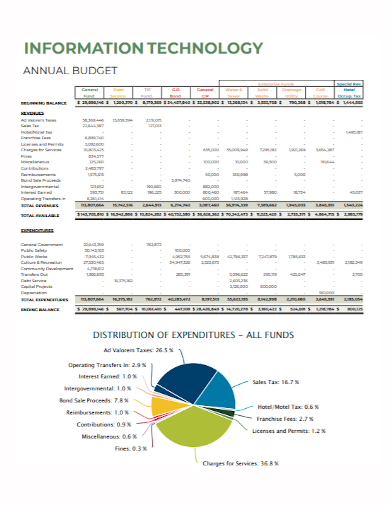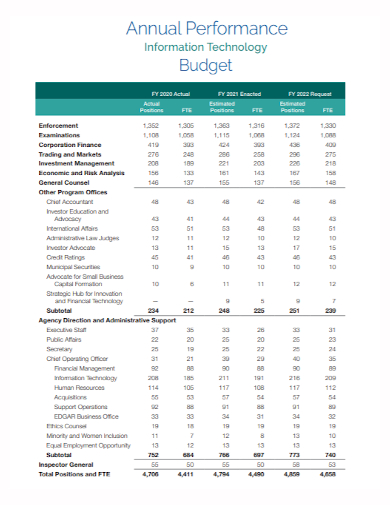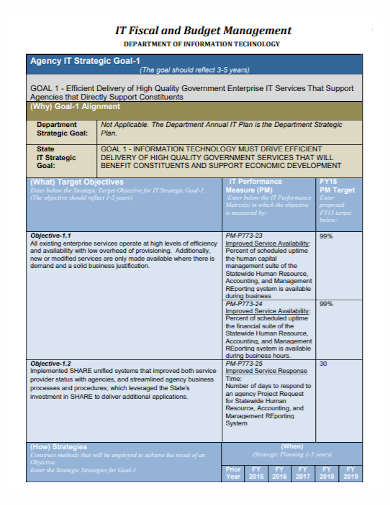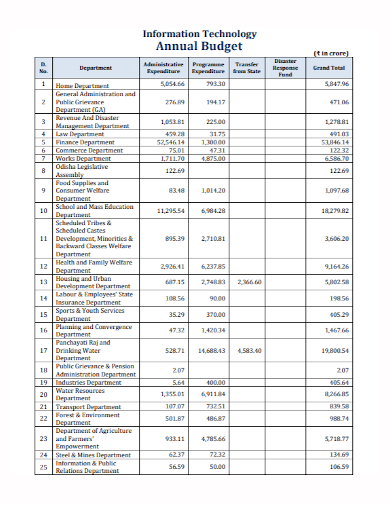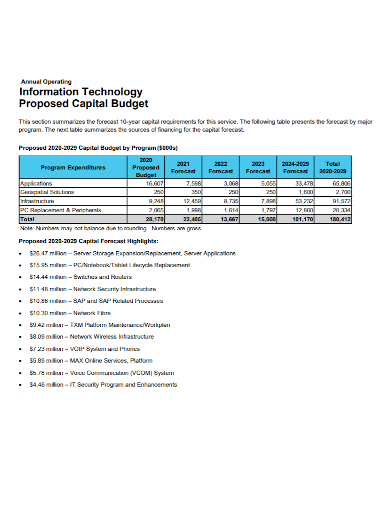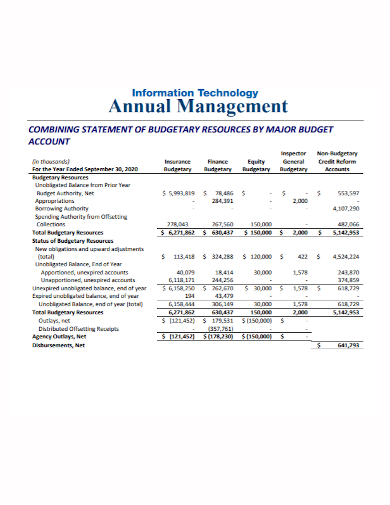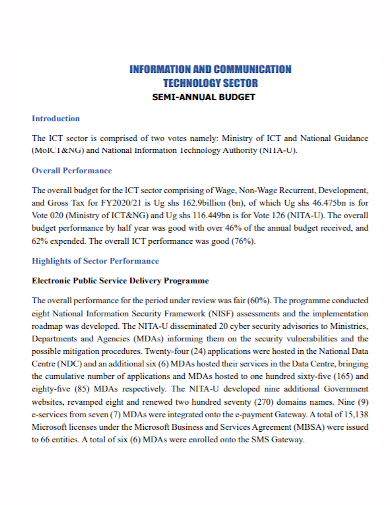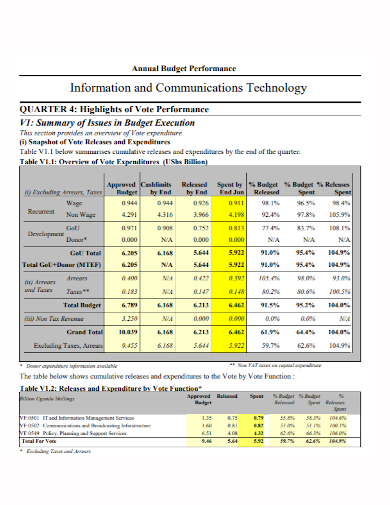Just like any other aspect of your company’s or organization’s operations, your IT structure needs an annual budget that will describe how you will spend money to reach your goals. IT budgeting can be a challenging annual task to create the budget and implement it to your IT strategies and justify the budget to your stakeholders and executives, but it is all worth it to invest well in this area since most companies and organizations rely on information technology for their operations and processes. This article will guide you on how to make an annual IT budget. Read the article below.
10+ Annual IT Budget Samples
1. Annual IT Budget Template

2. Simple Annual IT Budget Template

3. Annual Report IT Budget
4. Annual IT Budget
5. Annual Performance IT Budget
6. Annual IT Management Budget
7. Sample Annual IT Budget
8. Annual IT Capital Budget
9. Annual Management IT Budget
10. Annual IT Communication Budget
11. Annual IT Budget Summary
What is IT budgeting?
IT budgeting is the process of acquiring monetary resources for IT programs and procedures in a company or organization. This process could range from recurring expenses related to the IT department of the company.
How to Make an Annual IT Budget
1. Review Last Year’s IT Budget
If this isn’t the first time your company has made an IT budget, the first thing you should do is to review it and decide if there are changes that need to be made. It can also guide you on what expenses you’re going to have for the current year and how much budget you’re going to need.
2. Know the Cost of the Recurring Expenses
Just like any other type of expense, IT has some common recurring expenses too. This include:
- Cloud storage space
- Renewal of software licenses
- URL registration
- Content management systems
- Hardware and software costs
Keep in mind that your recurring costs differ from other companies so you need to take note of what and how your business spends money to identify the recurring expenses that may have been neglected and not included in your past budgets. If this is the first you create an IT budget, take note of your current recurring expenses.
3. Take Inventory of Your Equipment
Create a list of your IT equipment and determine how old are the items. When you complete your list, decide whether you need to update your equipment. A lot of companies purchase new desktops and laptops every 3 to 5 years. Keeping your old equipment may save you a lot of money from purchasing newer models, but if they are not working well, they could lower the productivity of your employees. You need to decide wisely which equipment are needed to be replaced with newer technology and which could remain. Other IT equipment that needs updating every few years are servers, WiFi routers, and mobile devices. If you need to upgrade your equipment, you need to create a budget for them. Know the average prices of this equipment to estimate your budget.
4. Consult Your Staff
Talk to your employees and managers and ask them for suggestions on what upgrades your IT equipment and tools your company needs that you don’t know about. Ask them also what they would like to see in next year’s IT budget. If you hear the same requests from the majority, consider adding those requests to your budget but make sure these requests will give you a good return on your investment.
5. Plan for the Future
Don’t forget to set aside a budget for research and development that will improve your company’s ability to compete with other companies and organizations in your industry. You can send managers to IT conferences to learn about upcoming products, hire coders to update your software or improve your IT infrastructure security against cyberthreats that could destroy your important data.
FAQs
What impact does the IT budget have on the company?
Making a budget for IT operations can increase the productivity of a company and even help make better business decisions because dating their technology can increase their chances of attracting more customers.
What is a typical IT budget?
A typical average budget of a small company spends 6.9% of its revenue on IT. For midsize companies, on average they spend 4.1% of their revenue and large companies spend 3.2%.
Why does IT budgeting matter?
IT budgeting matters because it helps identify and execute IT initiatives that are crucial for the different companies of a company.
A well-developed budget must be clear and understandable enough for your colleagues to use it to figure out any IT strategies that they can do to improve the IT operations of your company. Also if your budget is presented well to your executives, you have a high chance of getting approval with minimal pushback. To help you get started making the budget for your IT department, download our free sample templates above to use as your guide!
Related Posts
FREE 4+ Vacation Budget Planner Samples in PDF
FREE 10+ Budget Outline Samples in PDF | MS Word
FREE 10+ Conference Budget Samples in MS Word | MS Excel | Google Docs | Google Sheets | Apple Pages | PDF
FREE 10+ Monthly Budget Worksheet Samples in PDF | MS Word | Google Docs | Google Sheets | Excel
FREE 10+ Monthly Project Budget Samples in MS Word | MS Excel | Google Docs | Google Sheets | PDF
FREE 10+ Corporate Budget Samples in MS Word | MS Excel | Google Docs | Google Sheets | PDF
FREE 9+ Primary School Budget Samples in MS Word | Google Docs | Google Sheets | MS Excel | PDF
FREE 10+ Operational Budget Samples in PDF | DOC
FREE 5+ Budget Layout Samples in PDF
FREE 6+ Paycheck Budget Samples in PDF | MS Word
FREE 10+ Architecture Budget Samples in PDF
FREE 10+ Capital Budget Samples in PDF | MS Word | Google Docs | Google Sheets | Excel | Apple Numbers | Apple Pages
FREE 10+ Budget Tracker Samples in PDF | DOC
FREE 4+ Corporate Monthly Budget Samples in MS Word | Google Docs | Google Sheets | Excel
FREE 10+ Profit and Loss Budget Samples in MS Word | MS Excel | Google Docs | Google Sheets | Apple Pages | PDF


